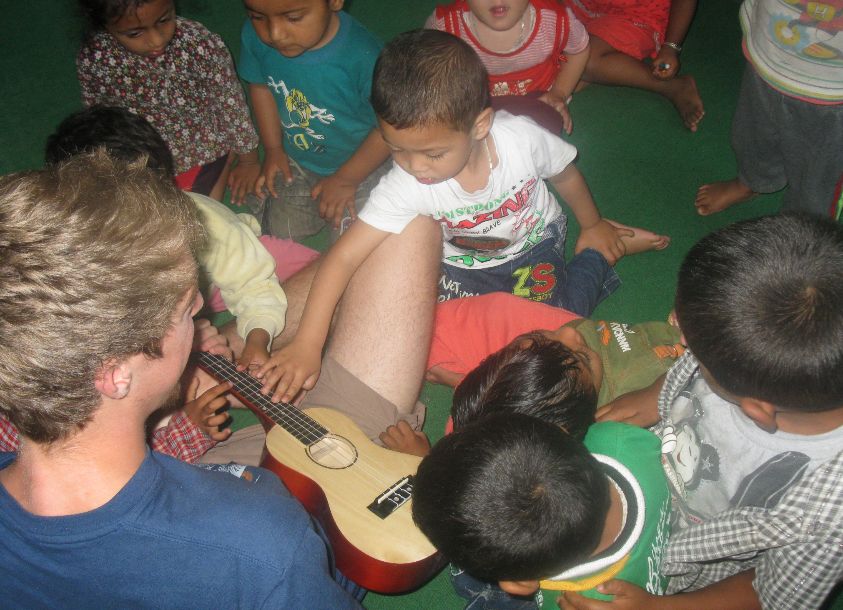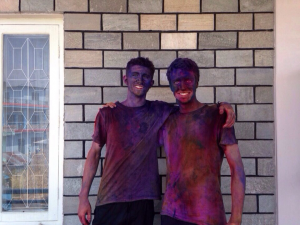
My Nepalese Adventure
With much excitement and anticipation, I embark on a flight with my friend Lewis which will take us more than 7000km away from home, halfway across the world. Upon my arrival in Nepal’s capital, Kathmandu, I know immediately that I have entered a completely alien world from the one I have just left.
An eclectic, intense and bohemian metropolis, Kathmandu struck me as a city which encapsulated Nepal’s ethos and problems perfectly: within seconds a throng of business-minded people surround me, offering a taxi, to act as a porter, to ‘shoe-shine’ my walking boots, as well as a congregation of curious individuals who gaze at me with a probing look or ‘puppy eyes’, begging for money.
A few days later I am boarding a plane again, this time to fly to Pokhara – a smaller city than the capital – located in an idyllic valley surrounded by lakes. I was welcomed by Som, a cheerful young man who is the treasurer for the charity CTAS, who would be helping organise my time here. He invites me to his neighbourhood, Gharipatan, to celebrate the festival of Shiva. We walk to his house, giving me the opportunity to take time to absorb my new surroundings. It is a dusty, rocky place, with a patchwork of interlocking narrow streets, irregularly shaped buildings which sprawl out in different directions and corner shops selling a farrago of items. Even here, one cannot escape global brands’ adverts as I spy a huge ‘San Miguel’ logo sprayed onto the side of a large house as well as numerous ‘Snickers’ and ‘Coca Cola’ billboards too.
The festival of Shiva involves a special version of their staple meal dal bhat, a meal consisting of rice (bhat) lentils (dal) spinach (saag) potato (aloo) and sometimes meat (masu). Afterwards a bonfire is lit in the evening and we thrust sugar cane sticks into the flames. These branches, once heated sufficiently, are then rapidly withdrawn from the fire, hoisted high above the head like a swordsman about to finish off his adversary, and smashed on the ground, shattering sizzling shards of sugar everywhere. The canes’ remnants are then eaten and music and dancing follow, to ensure the jubilant atmosphere prevails.
 One early morning, we reach Naya Pul ready to start our 10 day trek in the majestic Himalayas. The climbs on the trek are relentless, steep and demanding on the knees, and to make things harder, everyone in our group has their breath taken away every few minutes not just by the altitude, but also by the beautiful landscape. Unfortunately, my friend Lewis started suffering from a stomach bug and mild altitude sickness during the first few days in particular, which put my leadership skills to the test. I was placed in several extremely challenging situations in a harsh environment, but through teamwork, carrying his bags and maintaining constant communication we somehow manage to pull through and support him to Ghorepani. Here, Kumar (our guide) and I plan several eventualities for the trek and come up with a strategy for how best to aid his recovery. To Lewis’s credit, he stoically battles on and would later admit that the pain and difficulties were worthwhile in the end.
One early morning, we reach Naya Pul ready to start our 10 day trek in the majestic Himalayas. The climbs on the trek are relentless, steep and demanding on the knees, and to make things harder, everyone in our group has their breath taken away every few minutes not just by the altitude, but also by the beautiful landscape. Unfortunately, my friend Lewis started suffering from a stomach bug and mild altitude sickness during the first few days in particular, which put my leadership skills to the test. I was placed in several extremely challenging situations in a harsh environment, but through teamwork, carrying his bags and maintaining constant communication we somehow manage to pull through and support him to Ghorepani. Here, Kumar (our guide) and I plan several eventualities for the trek and come up with a strategy for how best to aid his recovery. To Lewis’s credit, he stoically battles on and would later admit that the pain and difficulties were worthwhile in the end.
Walking along the trail, I suddenly appreciate just how powerful the impact between the Indo-Australian and the Eurasian plates must have been in order to create the colossal summits. All around me I see many examples of geographical interest: glaciers, gorges, glacial troughs and erratics are all abundant. Indeed at Annapurna Base Camp, more than 4 kilometres above sea level, our arrival is marked with an enormous slab avalanche which crackles like thunder. In the vicinity I also observe a glacier, complete with trails of moraine, creaking its way down the mountain. Having studied such phenomena, it is truly amazing witnessing these first hand and gaining a better idea of the scale, power and physics of alpine landforms and processes.
Upon returning from our trek, I relocate away from the tourist district to the heart of a district called Gharipatan where there are only local residents. Once more, the contrast in living conditions to that of my hometown still astonishes me despite having seen pictures in the past, the reality of witnessing the extreme poverty upsets me. I become accustomed to seeing rubble beside the road, the drainage ditches drowning in rubbish, which discolours the water to a murky shade, and the majority of homes which are self-constructed, single-level simplistic abodes.
My arrival evokes a great deal of curiosity and conviviality in equal measure; I was forever hearing children calling out “Hello! How are you?” and “Where are you from my friend?” Despite the deprivation and hardship many Nepalese undergo each day, the locals are extremely hospitable, happy and friendly. I saw that the typical generosity of the Nepalese is epitomised by their meal-time customs. Their staple dinner dal bhat is always offered to guests first, and throughout the meal there are constant offers to replenish each component of my dish.
 Another festival coincided with our stay, and the Holi festival turned out to be a fantastic one to be part of. The day before Holi, Lewis and I find ourselves strolling through the neighbourhood with Som to visit a friend; Som barks out orders for the hundreds of excited children to target the two “white visitors” especially tomorrow for a bit of fun. Jubilantly they comply, much to our terror the following day, but the huge water and powder melée which ensues has a carnival-like ambiance. All ages participate and to the neighbourhood’s credit, it took us countless showers and over two weeks to finally eradicate the last bit of powder from our bodies! Our participation firmly cemented my and Lewis’s position as members of the local community, and we both felt truly integrated.
Another festival coincided with our stay, and the Holi festival turned out to be a fantastic one to be part of. The day before Holi, Lewis and I find ourselves strolling through the neighbourhood with Som to visit a friend; Som barks out orders for the hundreds of excited children to target the two “white visitors” especially tomorrow for a bit of fun. Jubilantly they comply, much to our terror the following day, but the huge water and powder melée which ensues has a carnival-like ambiance. All ages participate and to the neighbourhood’s credit, it took us countless showers and over two weeks to finally eradicate the last bit of powder from our bodies! Our participation firmly cemented my and Lewis’s position as members of the local community, and we both felt truly integrated.
Over the next few weeks, Lewis and I often visit the local nursery in the mornings to assist the two teachers who are responsible for teaching some very energetic kids. The children soon opened up to us and were extremely sweet-natured and interesting. Helping to teach them the alphabet, colours, numbers through songs, art and games soon became a routine and their progress spurred me on. For some individuals, I notice that perhaps a lack of attention and time has made them shy, but I am soon astonished at the hesitant characters’ ability to replicate and learn words and numbers.
 My communication skills were being tested having to teach English to a group of children without the ability to properly converse with them in their native tongue. However, the use of actions and simply showing an interest and patience usually delighted the children and provided me with an exclusive insight into their thoughts and even secrets (which sadly I could not understand).
My communication skills were being tested having to teach English to a group of children without the ability to properly converse with them in their native tongue. However, the use of actions and simply showing an interest and patience usually delighted the children and provided me with an exclusive insight into their thoughts and even secrets (which sadly I could not understand).
On a couple of days I bring in some items, which ensures that our status as mysterious but popular “uncles” is firmly cemented. The ‘magical’ equipment which aided us was balloons, bubble wands and a ukulele. The joy on the children’s faces and the euphoric pandemonium these items created was astounding, and the source of many beautiful moments.
Similarly, a visit to another school several miles away enables me to test my teaching abilities with more mature children. Having donated some toys and equipment and sweets, my artistic skills are put to the test as I attempt a vocabulary test on animals and some geography. I see that some of the children gain an appreciation of just how vast the Earth is, and an insight into the differing cultures of the West and Nepal. As with the kindergarten, the balloons and bubbles are a spectacular success!
In addition to teaching, I was asked by a trustee of the charity to inspect the water facilities which CTAS have installed with the help of funding from generous bodies. I had to examine and document the dharas (water tanks) so that the sponsors are able to see what their funding has provided and ensure the tanks have plaques stating who financed their construction. It is hoped that this will help to promote the NGO’s good work and possibly attract further funding for future projects.
 Overall, my trip to Nepal has left a lasting impression upon me. There are so many fantastic memories which will last a long time, but what will stay with me forever are the lessons I have learnt and the perspective I have gained from visiting Nepal. It has reminded me and emphasised to me just how fortunate I am to live in a relatively safe, stable country.
Overall, my trip to Nepal has left a lasting impression upon me. There are so many fantastic memories which will last a long time, but what will stay with me forever are the lessons I have learnt and the perspective I have gained from visiting Nepal. It has reminded me and emphasised to me just how fortunate I am to live in a relatively safe, stable country.
I certainly feel that this trip has aided my personal development. Living there has tested my independence, communication skills and leadership as well as widening my understanding of alpine environments, the daily hardships millions of poor people face in daily basic necessities and Asian culture. Moreover, my stay in Nepal has made me realise that I might improve some aspects of my personality, through the example of some people exhibiting very admirable traits, such as remarkable patience and altruism. I hope to improve myself, and replicate these venerable qualities so that I might be a better person and in turn, inspire someone else to better themselves.
Perhaps if we, who live in developed places such as Europe, took a few moments each day to assess what we have, the experiences we have been fortunate enough to have, and the ambitions we aspire to achieve, we will become more similar to the Nepalese in their outlook on life. I believe that the result of this would be a greater appreciation for the things we already have, their value and lead us to an ultimately happier and more fulfilling life.

